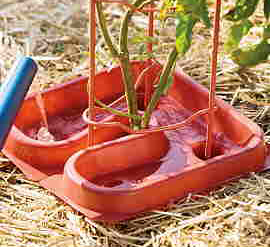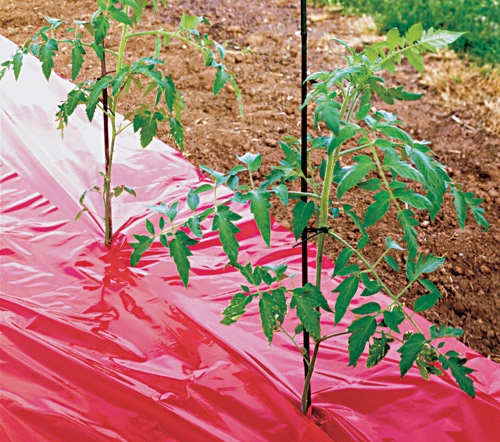Yesterday I got an interesting email about a new product – a Tomato Automator. Briefly, this square, red plastic disk slips around the stem of a tomato plant to suppress weeds and pests. Most intriguingly, we’re told that the color “triggers a natural plant protein that makes tomatoes mature faster and product more fruit.”

Given this is a red product, it’s likely that the protein referred to is phytochrome (literally, “plant pigment”). Phytochrome activity is maddeningly complicated to explain, so we’re going to keep this simple and refer (somewhat inaccurately) to “active” and “inactive” forms of phytochrome. The active form of phytochrome exists when red light is predominant and encourages leaf expansion, chlorophyll development, and other characteristic of plants growing in full sun. In contrast, the inactive form of phytochrome occurs when red light is reduced, either at night (when there’s no light) or in shaded conditions, where far-red light is predominant. (Far-red light occurs just outside our range of visual perception but is absorbed by phytochrome.)
From a practical standpoint, this means a plant can “tell” whether or not its light environment is limited: both red and blue light are absorbed by chlorophyll, so a low level of red light means poor photosynthetic conditions. Under such conditions, “inactive” phytochrome causes many plants to become etiolated (have abnormally long stems) in an attempt to outgrow the shade before it starves from lack of carbohydrate production. In addition, this photosynthetically-poor light environment can also increase fruit set by redirecting resources to seed production rather than foliage – perhaps a plant’s last effort to reproduce before it dies.

OK, now onto the useful application of this information. Several years ago researchers investigated that effect of different colored plastic mulches on tomato production. Again, to keep this simple we’ll just focus on the effect of red mulches. It’s pretty much agreed that red plastic mulch reflects both red and far-red light, increasing not only red light but paradoxically the relative levels of far-red light. Theoretically, this shift would cause tomatoes to put more resources into fruit production, and indeed some studies found this to be the case.
Unfortunately, the phenomenon is not consistent throughout repeated field studies. Some of the other confounding factors are soil temperature (warmer temperature = more growth), insect and disease pressure (both decrease tomato production and are variably influenced by mulch color), and the fact that ethylene production (the plant growth regulator responsible for fruit ripening) is not controlled by phytochrome at all.

So are Tomato Automators worth the trouble? Probably not, especially if you have many plants requiring many automators.
OK, this is pretty pathetic that I have to comment to my own posting. But I want you all to know that this posting was a stretch for me – I don’t do vegetable production and thought I’d try to broaden my horizons. Plus, explaining phytochrome is a pain in the butt, as the other GPs will readily admit. Was this posting worth doing? Or is it too technical/boring/irrelevant?
Your post was fascinating! It was very interesting and makes me want to read more about phytochrome. Looking at that tray, it seems like watering the plants is going to be a pain in the butt. That and around here the slugs would find them a positive boon to hide under during the day. The cost of the “automator” is $10.95 for a set of 3 or $7.95 a set if you order 2 or more; I can buy a 6’x8′ heavy duty red tarp online on sale for $6.88. That’d cover a lot more ground and last many more seasons if I was inclined to try something like that.
When you have idiots like me telling thousands of people that “I use red plastic mulch under my tomato plants”, then your post is not irrelevant. So, no red plastic mulch under my tomatoes this year. Besides, my wife says it’s ugly.
Hi Linda,
I am guessing the tray isn’t cheap so thank you for saving my time.
Cheers
Tim
One of my roommates worked for Iowa State Hort Farm and they were working on tomato trials that involved blue, black and red plastic mulch. I don’t know what the results were, but after the weighted the fruit and did their measurements I canned a ton of salsa.
Thanks for sharing the knowledge. This is a good technique, something new to me.
this was a great post! I am constantly amazed at the new fangled gadgets people are willing to spend money on; when good cultural practices have already been proven to work.
Linda, this post is great — for one thing, you’re really good at taking something like phytochrome and explaining it clearly, so that those of us whose eyes glaze over easily understand it. I like Bryn’s idea of finding a red tarp and using it; may just give it a shot with a sample of the tomato plants my community garden group will be growing, just for kicks. Woody plants are still my favorite, but it’s good to read about the other guys, too.
Anything and everything about tomatoes is a good thing, especially if it debunks an over-hyped sales pitch. How about a post on those upside down planters?
Excellent post, and a great overview of phytochrome. Thanks LInda, I look forward to more posts on vegetable production now!
When I read an article on using red plastic I bought some small red tarps. I tried it for 2 reasons, the tomato thing, and also because I wondered if it would draw in more hummingbirds as it would be so visible from the air. I can’t say that it helps with either! It also was too thin to be used for more than 1 growing season.
Thx for your article
Dang, Linda…I was about to order the red plastic mulch from Johnny’s. I even re-read the Clemson study from a few years ago. I’m one of those tomato-obsessed people – ANYTHING for a Competitive Edge!!!
Thank you for debunking the red mulch, red plastic, red gizmo improves tomato production idea.
As for the slugs hiding under the tray – why not just fill the tray with beer, and invite them up to their death 🙂
Yes thank you for letting us know that the red plastic thing is not as promoted. Also, great to learn about the phytochrome stuff! Good job!
It is a very useful blog and very important information about Mulch.